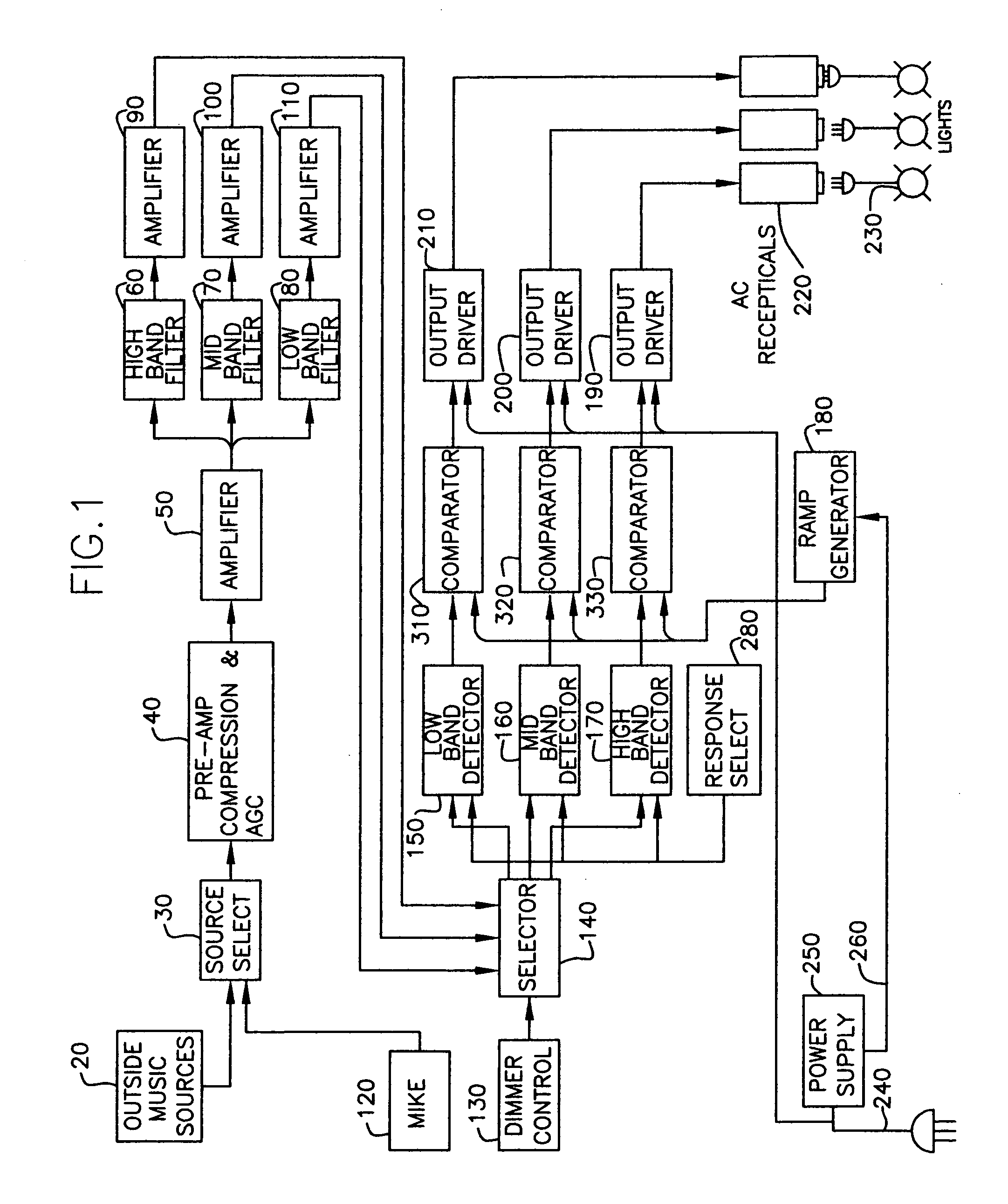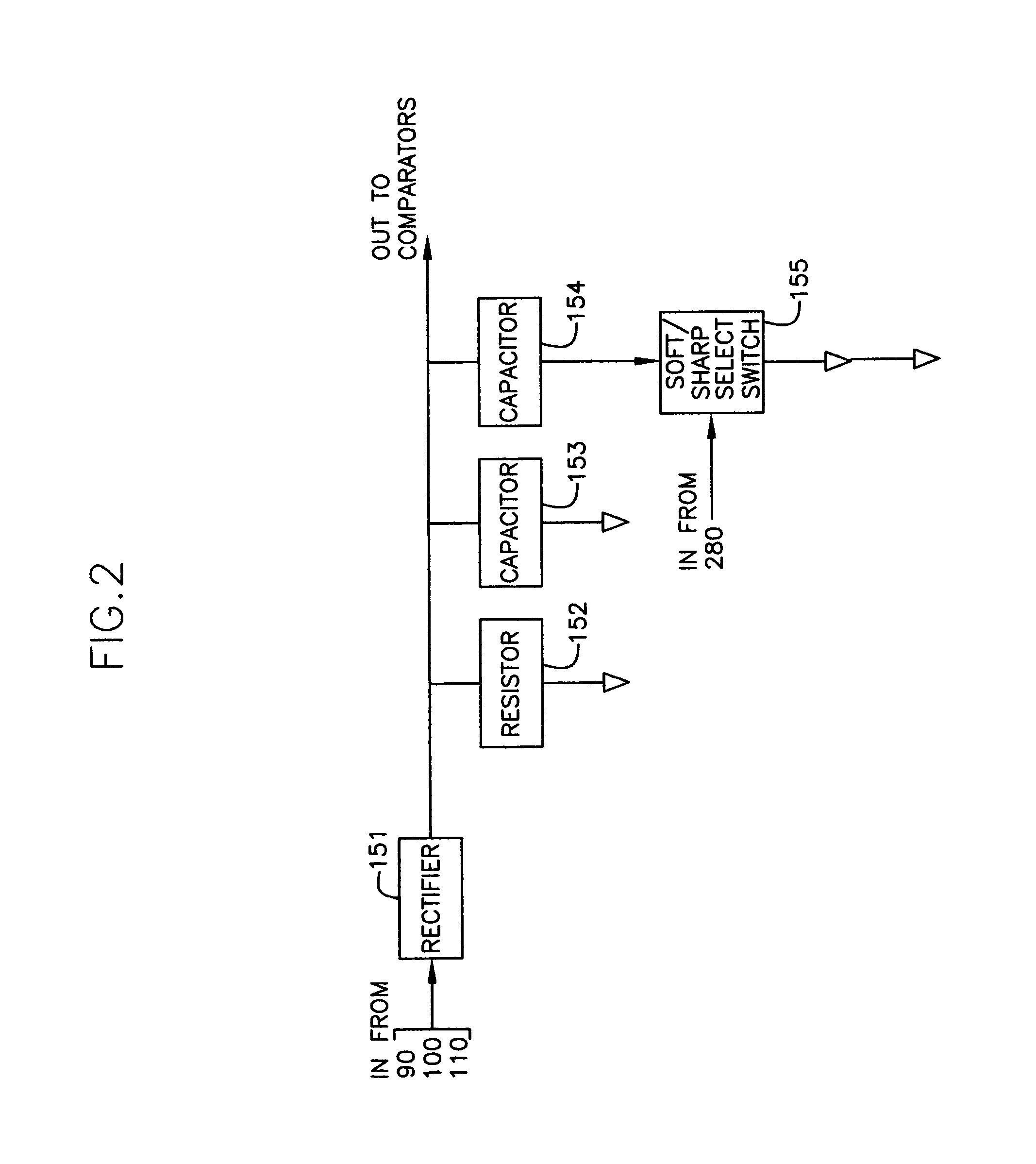Method of and apparatus for controlling a source of light in accordance in a source of sound
a technology of light and sound, which is applied in the direction of instruments, electrophonic musical instruments, signalling systems, etc., can solve the problems of poor light response to music, poor response of the output voltage to changes in the audio, and poor audio signal response to prior art light control implementations, so as to prevent any light production
- Summary
- Abstract
- Description
- Claims
- Application Information
AI Technical Summary
Benefits of technology
Problems solved by technology
Method used
Image
Examples
embodiment 2
Embodiment 2 differs from the preferred form in the following items:
[0055]Item 250 is the power supply and is changed in Embodiment 2 to provide a regulated plus 5 volts, a regulated negative 5 volts and the sync pulse for the ramp generator item 180.
[0056]Item 43, an amplifier (See FIG. 7), is changed from Analog Devices SSM2165-1 to Analog Devices SSM2167-1. Resistor 48 and potentiometer 51 provide a means for the operator to adjust the noise floor, which sets the level at which the background is rejected. Resistor 49 and potentiometer 52 provide a means for the operator to adjust the compression ratio and thus the response of the lights connected to the outputs to the lights to be adjusted for the most pleasing response to the music.
[0057]Items 60, 70 and 120 (See FIG. 5) are three band filters. These filters are changed from a three band filter using operational amplifiers to three switched capacitor filters. The band filters in this embodiment are set with a much sharper cutoff...
embodiment 3
[0060]Item 120, the internal microphone is not included in Embodiment 3.
[0061]Item 30 is changed in embodiment 3 by adding provisions for line input, speaker input, low impedance microphone, or high impedance microphone. There are provisions for the microphone inputs to be fed through; the microphone input connector is directly connected to an output connector. The microphone may be plugged into the unit and be directly connected to an output which can feed an audio amplifier while the signal is tapped off to feed into the inputs of the lighting control. Similarly the speaker right and left signals can be fed in and the out to speakers while the signal is tapped off for an input to the lighting control.
[0062]Item 40 in Embodiment 3 (See FIG. 8), as in Embodiment 2, make use of the special amplifier from Analog Devices, SSM2167. As in Embodiment 2, there is a provision for operator adjustment of the noise floor, the level below which background noise will be rejected. As in Embodimen...
embodiment 4
[0070]Embodiment 4(See FIG. 10A) makes use of transistorized outputs, with pulse width modulation to provide a near unity input power factor instead of using triacs with phase control. Triacs and SCR's, depending on the degree to which they are phased on, have poor input power factor. When used as in the Preferred Form, and Embodiments 2 and 3 the input power factor will vary with the brightness of the lights, items 230, connected to the outlets, items 190, 200, and 210. For higher powers it becomes more important to have a near unity power factor. Pulse width modulation also provides a near linear power output response to the audio signal.
[0071]Item 250, the power supply for the control circuits provides a regulated positive 5 volts and a regulated minus 5 volts as in Embodiments 2 and 3, but it does not provide a sync signal as in the prior embodiments.
[0072]Item 180, the ramp generator is not used in Embodiment 4.
[0073]Item 560 is a triangular wave generator, that provides a tria...
PUM
 Login to View More
Login to View More Abstract
Description
Claims
Application Information
 Login to View More
Login to View More - R&D
- Intellectual Property
- Life Sciences
- Materials
- Tech Scout
- Unparalleled Data Quality
- Higher Quality Content
- 60% Fewer Hallucinations
Browse by: Latest US Patents, China's latest patents, Technical Efficacy Thesaurus, Application Domain, Technology Topic, Popular Technical Reports.
© 2025 PatSnap. All rights reserved.Legal|Privacy policy|Modern Slavery Act Transparency Statement|Sitemap|About US| Contact US: help@patsnap.com



